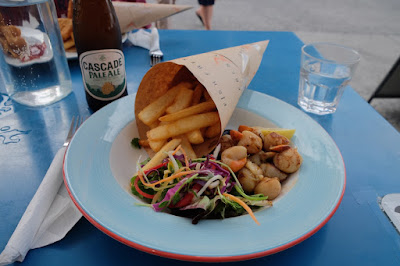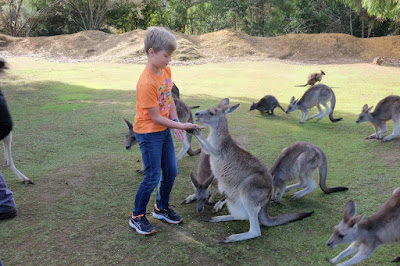As my parents made the trek back to the US from Sydney, we headed from Sydney south to Tasmania. The flight was an easy couple of hours, so by mid-afternoon we were in Hobart, the capital of Tasmania (which is the smallest of Australia's 6 states). We walked around this compact, relaxed little city, stopping at this beautiful little park surrounded by the most picturesque houses.
We found a geocache that took a bit more effort than others.
And we ate Tassie scallops and chips (paired with a local Hobart beer) at Fish Frenzy, a restaurant right on the Hobart waterfront. Delicious.
The next morning, we made our way to MONA, the Museum of Old and New Art. We typically prefer history and/or ethnography museums, but we'd been told that this was an art museum not to be missed. And were "they" right......this museum was INCREDIBLE. You know it's not going to be a "typical" art museum when you walk past something like this on your way in (the Tesla on the left is the museum owner's and in "God's" spot).
MONA is a massive collection of antiquities, modern, and contemporary art. Instead of having rooms dedicated to specific art schools or movements, old and new are displayed next to each other. The fantastic audio guide discussed overarching themes and questions that you could equally apply to Egyptian mummies, landscapes, cars, and even "adult" art (there were a couple of rooms not suitable for the boys). The commenters on the guide were experts in various fields such as art, science, and psychology, and so we were not just learning about the piece in front of us but also considering ideas of beauty, privacy, selection, technology, biology...........it was an absolutely thought-provoking and original museum.
This is one of MONA's most popular exhibits, and it gave an introduction to what MONA was going to be like. This waterfall sends streams of water down in the shapes of words. The words themselves are pulled from real-time Google searches, so you see words that are currently trending online. The speed of the waterfall means that just as you're able to read and start to think about the word, another one is falling......so the viewer has to "keep up" and has little time to think about one word before being forced to move on to the next. As the audioguide explained, this piece was designed to make us think about not only the the words/ideas themselves represented on the internet and in modern life in general, but also the fact that we're always trying to "keep up" and never fully considering one thing before moving on to the next. Is this technology helping or hurting us? Is it changing human understanding and interaction for good or for bad?
A temporary exhibit entitled On the Origin of Art asked 4 scientists the question, "We need art. But for what?" Each of 4 rooms examined art from a different perspective (evolutionary biology, for example), making 4 cases as to what the "purpose" of art is. The pictures below are from this exhibit and some of our favorite parts.
Emmett was excited to examine this mummy to find and explain many hieroglyphics that he knows from his love of Egyptian mythology.
This carpet, created using traditional techniques, had a decidedly non-traditional twist...close up, it looked like the carpet was melting off the wall and into the floor. I loved it.
In the museum's more permanent collection, there was a "poop machine" that "eats" and "poops" multiple times a day. It's another one of the museum's more (in)famous exhibits, and it drew quite a crowd for the 2 PM pooping. The mechanisms behind the whole thing were interesting, but we all felt the "pooping" was a bit over-hyped and uninteresting.
This car brought up themes of consumerism and overconsumption.......
And outside there was even more "rusty metal", aka steampunk art. All in all, MONA was an incredible museum that was one of the highlights of our entire time in Tassie!
The next day, we drove down the Tasman Peninsula. Our first stop was the Tasmanian Devil Unzoo, so we could see this cute little fellow.....
....cute until he's ready to rip you to shreds!
We listened to a park guide discuss the Tasmanian Devils, including their extremely low numbers due to a contagious facial cancer that has spread rapidly through the population. Centers such as the Unzoo are trying to help boost the numbers of cancer-free Tasmanian Devils in order to strengthen the general population. Then he fed this Tassie Devil, who quickly devoured a meal of muscle and bone.
We also saw pademelons...
...and kangaroos! It was our first chance to get up close and personal with them, which was so neat!
We watched young kangaroos making all kinds of funny moves....
These two guys were fighting with each other a bit until a mom kangaroo got involved and shooed them off...
This mom has a joey peeking out of her pouch.
We all got to feed the kangaroos, too.
Here's the mom and joey again, this time closer up. We saw another mom whose joey had only its foot sticking out of the pouch.
There was also a short presentation of some of the birds found in Tasmania. The birds at the center have been rehabilitated after injuries and either live permanently at the Unzoo or are released back into the wild, when possible. This bird landed on Colin's arm and took a coin from him.
This bird looked a bit like a crotchety old Muppet to me, but he's technically called a Tawny Frogmouth.
From the Unzoo we headed to Port Arthur, one of the most significant sites in Australia's history as a penal colony.
We took a short boat cruise to see the sites from the water, including the Isle of the Dead. It was there that over 1,000 prisoners who died while at Port Arthur were buried.
There was also an island which was the site of Point Puer Boys' Prison. Between 1834 and 1849, some 3,000 boys were brought here after being convicted of crimes in Britain. The youngest was just 9 years old. The beautiful scenery completely contradicted the ugly history of children being imprisoned here.
The criminals who were sent to Port Arthur were those who'd been sent from Britain to other Australian prisons and who had reoffended there. The Tasman Peninsula was a very secure site, since it was surrounded by water on 3 sides. A 30 meter wide isthmus, which is the connection to the rest of Tasmania, was guarded by men and half-starved dogs. The prison was used until 1877, when it was abandoned. While at Port Arthur, the convicts were subjected to hard labour and difficult living conditions.
This building was built and used as a flour mill before it was converted into a penitentiary to house over 480 convicts.
This was the hospital.
There was the Separate Prison, which was built to solitarily confine certain prisoners. There was a central "surveillance core", from which extended 4 wings of solitary cells with an exercise yard for each. Prisoners were kept completely isolated, including during their one hour daily exercise time.
This was the chapel, where services were held for the men in the Separate Prison.
The space was designed such that the men were still isolated from one another, but they could each individually see the preacher. Emmett is standing in the old pulpit.
Also on the grounds of Port Arthur were beautiful homes that housed prison officers and their families. The women and children who lived on the prison grounds were effectively prisoners themselves as they couldn't go outside or move from place to place without a guard.
Since they had to spend most of their time indoors, many of the wives elaborately decorated their homes in European styles, including this sitting room with a fake Italian marble floor.
Throughout our visit, the boys worked on a children's guide which gave them specific information and activities to complete. Colin finished up his guide at the dock yard, which was were convict laborers constructed hundreds of boats. It was the last stop on our full afternoon of "convict history" at Port Arthur.
On the way back to our AirBnB outside Hobart, we stopped at a blowhole and the Tasman Arch, a natural bridge high above the water.
We saw a few more new-to-us road signs, including one for the Tasmanian Devil and another for kangaroos.
And we ended the day with some beautiful views of the sun setting over Tasmania!



























































No comments:
Post a Comment